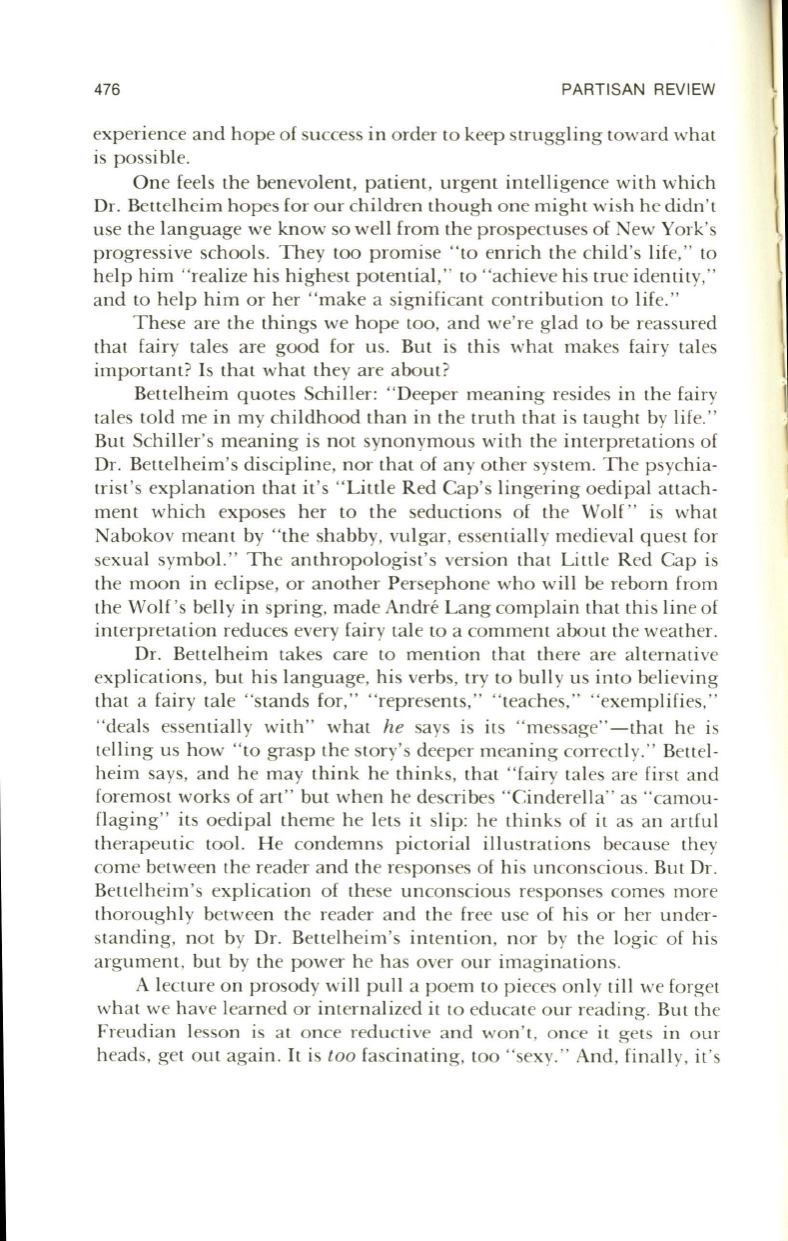
476
PARTISAN REVIEW
experience and hope of success in order to keep struggling toward what
is possible.
One feels the benevol ent, patient, urgent intelligence with which
Dr. Bettelheim hopes for our children though one might wish he didn 't
use the language we know so well from the prospectuses of New York 's
progressive schools . They too promise " to enri ch the child's life, " to
help him " realize hi s highes t potential ," to " achi eve his true identity,"
and to help him or her "make a significant contributi on to life. "
These are the things we hope too, and we're glad to be reassured
that fair y tales are good for us. But is this wha t ma kes fairy tales
important? Is that wha t they are about ?
Bettelheim quotes Schiller : "Deeper meaning resides in the fairy
tales told me in my childhood than in the truth that is taught by life."
But Schill er's meaning is no t synonymous with the interpreta tions of
Dr. Bettelheim 's discipline, nor that of any other system. The psychi a–
trist's expl anation that it's " Little Red Cap's lingering oedipa l attach–
ment whi ch exposes her to the seduction s of the Wolf " is what
Nabokov meant by " the shabby, vulgar, essentiall y medi eval quest for
sexual symboL" The anthropo logi st's version tha t Little Red Cap is
the moon in eclipse, or ano ther Persephone who will be reborn from
the Wolf's belly in spring, made Andre Lang compl ain tha t thi s line of
interpreta tion reduces every fairy tale to a comment about the weather.
Dr. Bettelheim takes care to mention tha t there a re alterna ti ve
expli cati ons, but hi s language, his verbs, try to bull y us in to believing
that a fairy tal e "stands for ," " represents," " teaches," " exemplifi es, "
" dea ls essenti all y with " what
he
says is its " message" -tha t he is
telling us how " to grasp the story's deeper meaning correctl y." Bettel–
heim says, and he may think he thinks, tha t " fairy tales are first and
foremost works of art " but when he describes " Cinderell a" as " camou–
fl aging" its oedipal theme he lets it slip: he thinks of it as an artful
therapeuti c tool. He condemns pi ctori al illustra ti ons because they
come between the reader and the responses of his unconscio us. But Dr .
Bettelheim 's explica tion o f these unconscious res ponses comes more
thoroughly between the reader and the fr ee use of hi s or her under–
standing, not by Dr. Bettelheim 's intenti on , nor by the logic of his
argument, but by the power he has over our imagina ti o ns.
A lecture on prosody will pull a poem to pi eces onl y till we forget
wh at we have learned or internalized it to educa te our reading. But the
Freudian lesson is a t once reductive and won 't, once it gets in o ur
heads, get out again .
It
is
too
fascina tin g, too "sexy." And , fin all y, it's
\


